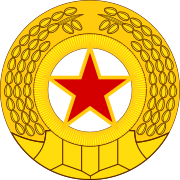| Korean People's Army | |
|---|---|
| 조선인민군 Chosŏn inmin'gun | |
 Emblem of the Korean People's Army | |
 Flag of the Korean People's Army | |
| Founded | 25 April 1932 |
| Current form | 8 February 1948 |
| Service branches | |
| Headquarters | State Affairs Commission, Pyongyang |
| Leadership | |
| Governing body | |
| CMC leadership | Chairman: |
| Minister of Defence | |
| Chief of the General Staff | |
| Director of the General Political Bureau | |
| Personnel | |
| Military age | 17–30 |
| Conscription | 18 |
| Active personnel | 1,320,000[1] (ranked 5th) |
| Reserve personnel | 560,000+[1] |
| Expenditure | |
| Budget | Approximately US$4 billion (2019)[2] |
| Percent of GDP | Approximately 26% (2019)[2] |
| Industry | |
| Domestic suppliers | |
| Foreign suppliers |
|
| Related articles | |
| Ranks | Military ranks of North Korea |
| Korean People's Army | |
| Chosŏn'gŭl | 조선인민군 |
|---|---|
| Hancha | 朝鮮人民軍 |
| Revised Romanization | Joseon Inmingun |
| McCune–Reischauer | Chosŏn Inmingun |
 |
|---|
|
|
The Korean People's Army (KPA; Korean: 조선인민군; MR: Chosŏn inmin'gun) encompasses the combined military forces of North Korea and the armed wing of the Workers' Party of Korea (WPK). The KPA consists of five branches: the Ground Force, the Naval Force, the Air Force, Strategic Force, and the Special Operation Force. It is commanded by the WPK Central Military Commission, which is chaired by the WPK general secretary, and the president of the State Affairs; both posts are currently headed by Kim Jong Un.
The KPA considers its primary adversaries to be the Republic of Korea Armed Forces and United States Forces Korea, across the Korean Demilitarized Zone, as it has since the Armistice Agreement of July 1953. As of 2021[update] it is the second largest military organisation in the world, with 29.9% of the North Korean population actively serving, in reserve or in a paramilitary capacity.[3][4]
- ^ a b IISS 2023, pp. 280–281.
- ^ a b "North Korea sustains high defense spending with new budget". The Associated Press. 2024. Retrieved 25 August 2024.
- ^ UNFPA (1 October 2009). 한반도 인구 7천400만명 시대 임박 (in Korean). United Nations. Archived from the original on 24 May 2013. Retrieved 21 November 2012.
- ^ "DPR Korea 2008 Population Census: National Report" (PDF). Archived from the original (PDF) on 31 March 2010. Retrieved 19 February 2011.